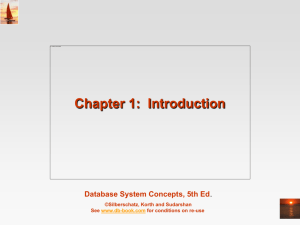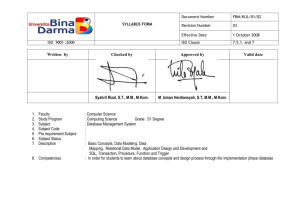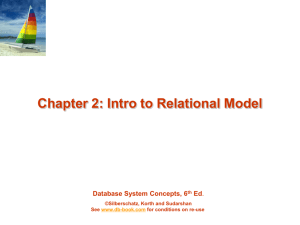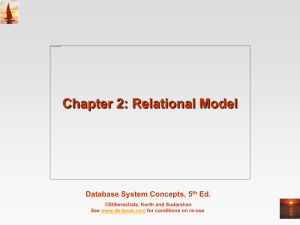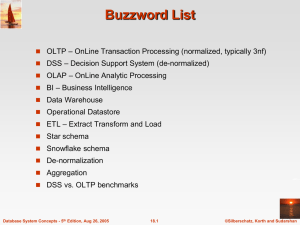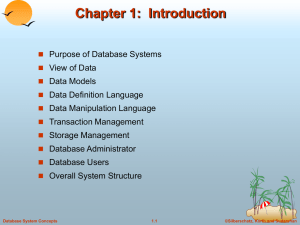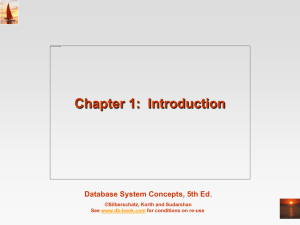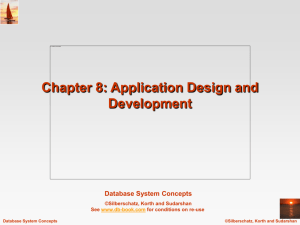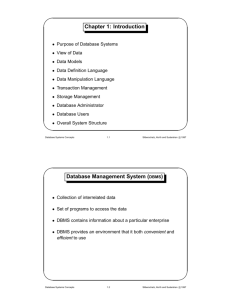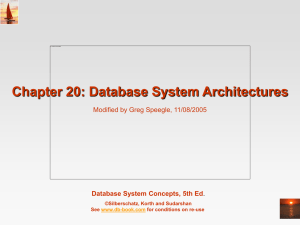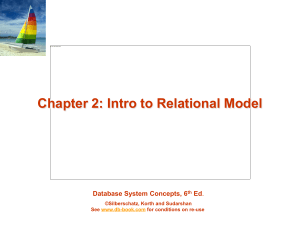Chapter 1: Introduction
advertisement
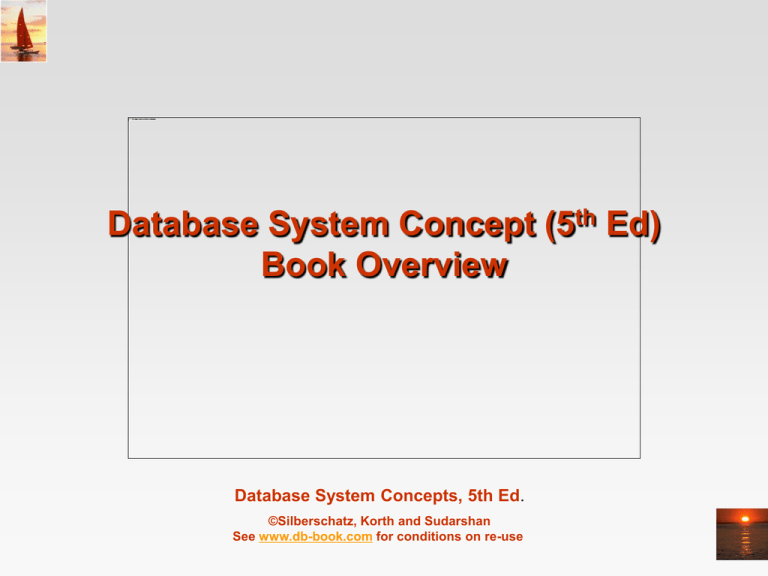
Database System Concept (5th Ed) Book Overview Database System Concepts, 5th Ed. ©Silberschatz, Korth and Sudarshan See www.db-book.com for conditions on re-use Overview (Chapter 1). Chapter 1 provides a general overview of the nature and purpose of database systems. We explain how the concept of a database system has developed, what the common features of database systems are, what a database system does for the user, and how a database system interfaces with operating systems. We also introduce an example database application: a banking enterprise consisting of multiple bank branches. This example is used as a running example throughout the book. This chapter is motivational, historical, and explanatory in nature. Database System Concepts - 5th Edition, May 23, 2005 1.2 ©Silberschatz, Korth and Sudarshan Part 1: Relational databases (Chapters 2 through 5). Chapter 2 introduces the relational model of data, covering basic concepts as well as the relational algebra. The chapter also provides a brief introduction to integrity constraints. Chapters 3 and 4 focus on the most influential of the user-oriented relational languages: SQL. While Chapter 3 provides a basic introduction to SQL, Chapter 4 describes more advanced features of SQL, including how to interface between a programming language and a database supporting SQL. Chapter 5 covers other relational languages, including the relational calculus, QBE and Datalog. The chapters in this part describe data manipulation: queries, updates, insertions, and deletions, assuming a schema design has been provided. Schema design issues are deferred to Part 2. Database System Concepts - 5th Edition, May 23, 2005 1.3 ©Silberschatz, Korth and Sudarshan Part 2: Database Design (Chapters 6 through 8). Chapter 6 provides an overview of the database-design process, with major emphasis on database design using the entity-relationship data model. The entityrelationship data model provides a high-level view of the issues in database design, and of the problems that we encounter in capturing the semantics of realistic applications within the constraints of a data model. UML class-diagram notation is also covered in this chapter. Chapter 7 introduces the theory of relational-database design. The theory of functional dependencies and normalization is covered, with emphasis on the motivation and intuitive understanding of each normal form. This chapter begins with an overview of relational design and relies on an intuitive understanding of logical implication of functional dependencies. This allows the concept of normalization to be introduced prior to full coverage of functional-dependency theory, which is presented later in the chapter. Instructors may chose to use only this initial coverage in Sections 7.1 through 7.3 without loss of continuity. Instructors covering the entire chapter will benefit from students having a good understanding of normalization concepts to motivate some of the challenging concepts of functional-dependency theory. Chapter 8 covers application design and development. This chapter emphasizes the construction of database applications with Web-based used interfaces. In addition, the chapter covers application security. Database System Concepts - 5 Edition, May 23, 2005 1.4 ©Silberschatz, Korth and Sudarshan th Part 3: Object-based databases and XML (Chapters 9 and 10). Chapter 9 covers object-based databases. The chapter describes the object-relational data model, which extends the relational data model to support complex data types, type inheritance, and object identity. The chapter also describes database access from object-oriented programming languages. Chapter 10 covers the XML standard for data representation, which is seeing increasing use in the exchange and storage of complex data. The chapter also describes query languages for XML. Database System Concepts - 5th Edition, May 23, 2005 1.5 ©Silberschatz, Korth and Sudarshan Part 4: Data storage and querying (Chapters 11 through 14). Chapter 11 deals with disk, file, and file-system structure. A variety of data-access techniques are presented in Chapter 12, including hashing and B+ tree indices. Chapters 13 and 14 address query-evaluation algorithms, and query optimization. These chapters provide an understanding of the internals of the storage and retrieval components of a database. Database System Concepts - 5th Edition, May 23, 2005 1.6 ©Silberschatz, Korth and Sudarshan Part 5: Transaction management (Chapters 15 through 17). Chapter 15 focuses on the fundamentals of a transaction-processing system, including transaction atomicity, consistency, isolation, and durability, as well as the notion of serializability. Chapter 16 focuses on concurrency control and presents several techniques for ensuring serializability, including locking, timestamping, and optimistic (validation) techniques. The chapter also covers deadlock issues. Chapter 17 covers the primary techniques for ensuring correct transaction execution despite system crashes and disk failures. These techniques include logs, checkpoints, and database dumps. Database System Concepts - 5th Edition, May 23, 2005 1.7 ©Silberschatz, Korth and Sudarshan Part 6: Data Mining and Information Retrieval (Chapters 18 and 19). Chapter 18 introduces the concept of a data warehouse and explains data mining and online analytical processing (OLAP), including SQLNN support for OLAP and data warehousing. Chapter 19 describes information retrieval techniques for querying textual data, including hyperlink-based techniques used in Web search engines. Part 6 uses the modeling and language concepts from Parts 1 and 2, but does not depend on Parts 3, 4, or 5. It can therefore be incorporated easily into a course that focuses on SQL and on database design. Database System Concepts - 5th Edition, May 23, 2005 1.8 ©Silberschatz, Korth and Sudarshan Part 7: Database system architecture (Chapters 20 through 22). Chapter 20 covers computer-system architecture, and describes the influence of the underlying computer system on the database system. We discuss centralized systems, client-server systems, parallel and distributed architectures, and network types in this chapter. Chapter 21, on parallel databases explores a variety of parallelization techniques, including I/O parallelism, interquery and intraquery parallelism, and interoperation and intraoperation parallelism. The chapter also describes parallel-system design. Chapter 22 covers distributed database systems, revisiting the issues of database design, transaction management, and query evaluation and optimization, in the context of distributed databases. The chapter also covers issues of system availability during failures and describes the LDAP directory system. Database System Concepts - 5th Edition, May 23, 2005 1.9 ©Silberschatz, Korth and Sudarshan Part 8: Other topics (Chapters 23 through 25). Chapter 23 covers performance benchmarks, performance tuning and standardization. Chapter 24 covers advanced data types and new applications, including temporal data, spatial and geographic data, multimedia data, and issues in the management of mobile and personal databases. Finally, Chapter 25 deals with advanced transaction processing. We discuss transaction-processing monitors, high-performance transaction systems, real-time transaction systems, and transactional workflows. Database System Concepts - 5th Edition, May 23, 2005 1.10 ©Silberschatz, Korth and Sudarshan Part 9: Case studies (Chapters 26 through 29). In this part we present case studies of four leading database systems, including PostgreSQL, Oracle, IBM DB2, and Microsoft SQL Server. These chapters outline unique features of each of these systems, and describe their internal structure. They provide a wealth of interesting information about the respective products, and help you see how the various implementation techniques described in earlier parts are used in real systems. They also cover several interesting practical aspects in the design of real systems. Database System Concepts - 5th Edition, May 23, 2005 1.11 ©Silberschatz, Korth and Sudarshan Online appendices . Although most new database applications use either the relational model or the object-relational model, the network and hierarchical data models are still in use in some legacy applications. For the benefit of readers who wish to learn about these data models, we provide appendices describing the network and hierarchical data models, in Appendices A and B respectively; the appendices are available only online (http://www.db-book.com). Appendix C describes advanced relational-database design, including the theory of multivalued dependencies, join dependencies, and the project-join and domain-key normal forms. This appendix is for the benefit of individuals who wish to study the theory of relationaldatabase design in more detail, and instructors who wish to do so in their courses. This appendix, too, is available only online, on the Web page of the book. Database System Concepts - 5th Edition, May 23, 2005 1.12 ©Silberschatz, Korth and Sudarshan
